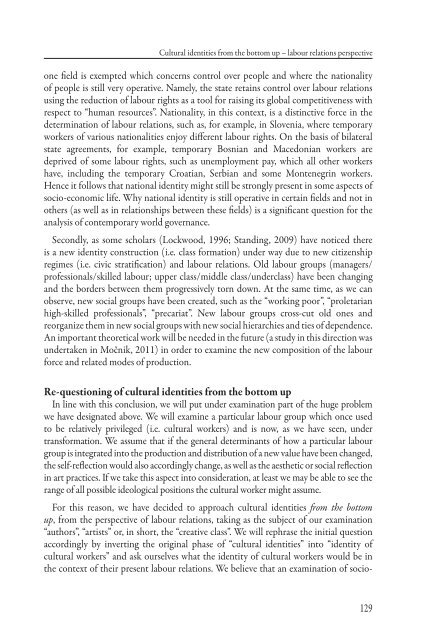Cultural Identity Politics in the (Post-)Transitional Societies
Cultural Identity Politics in the (Post-)Transitional Societies
Cultural Identity Politics in the (Post-)Transitional Societies
You also want an ePaper? Increase the reach of your titles
YUMPU automatically turns print PDFs into web optimized ePapers that Google loves.
<strong>Cultural</strong> identities from <strong>the</strong> bottom up – labour relations perspective<br />
one field is exempted which concerns control over people and where <strong>the</strong> nationality<br />
of people is still very operative. Namely, <strong>the</strong> state reta<strong>in</strong>s control over labour relations<br />
us<strong>in</strong>g <strong>the</strong> reduction of labour rights as a tool for rais<strong>in</strong>g its global competitiveness with<br />
respect to “human resources”. Nationality, <strong>in</strong> this context, is a dist<strong>in</strong>ctive force <strong>in</strong> <strong>the</strong><br />
determ<strong>in</strong>ation of labour relations, such as, for example, <strong>in</strong> Slovenia, where temporary<br />
workers of various nationalities enjoy different labour rights. On <strong>the</strong> basis of bilateral<br />
state agreements, for example, temporary Bosnian and Macedonian workers are<br />
deprived of some labour rights, such as unemployment pay, which all o<strong>the</strong>r workers<br />
have, <strong>in</strong>clud<strong>in</strong>g <strong>the</strong> temporary Croatian, Serbian and some Montenegr<strong>in</strong> workers.<br />
Hence it follows that national identity might still be strongly present <strong>in</strong> some aspects of<br />
socio-economic life. Why national identity is still operative <strong>in</strong> certa<strong>in</strong> fields and not <strong>in</strong><br />
o<strong>the</strong>rs (as well as <strong>in</strong> relationships between <strong>the</strong>se fields) is a significant question for <strong>the</strong><br />
analysis of contemporary world governance.<br />
Secondly, as some scholars (Lockwood, 1996; Stand<strong>in</strong>g, 2009) have noticed <strong>the</strong>re<br />
is a new identity construction (i.e. class formation) under way due to new citizenship<br />
regimes (i.e. civic stratification) and labour relations. Old labour groups (managers/<br />
professionals/skilled labour; upper class/middle class/underclass) have been chang<strong>in</strong>g<br />
and <strong>the</strong> borders between <strong>the</strong>m progressively torn down. At <strong>the</strong> same time, as we can<br />
observe, new social groups have been created, such as <strong>the</strong> “work<strong>in</strong>g poor”, “proletarian<br />
high-skilled professionals”, “precariat”. New labour groups cross-cut old ones and<br />
reorganize <strong>the</strong>m <strong>in</strong> new social groups with new social hierarchies and ties of dependence.<br />
An important <strong>the</strong>oretical work will be needed <strong>in</strong> <strong>the</strong> future (a study <strong>in</strong> this direction was<br />
undertaken <strong>in</strong> Močnik, 2011) <strong>in</strong> order to exam<strong>in</strong>e <strong>the</strong> new composition of <strong>the</strong> labour<br />
force and related modes of production.<br />
Re-question<strong>in</strong>g of cultural identities from <strong>the</strong> bottom up<br />
In l<strong>in</strong>e with this conclusion, we will put under exam<strong>in</strong>ation part of <strong>the</strong> huge problem<br />
we have designated above. We will exam<strong>in</strong>e a particular labour group which once used<br />
to be relatively privileged (i.e. cultural workers) and is now, as we have seen, under<br />
transformation. We assume that if <strong>the</strong> general determ<strong>in</strong>ants of how a particular labour<br />
group is <strong>in</strong>tegrated <strong>in</strong>to <strong>the</strong> production and distribution of a new value have been changed,<br />
<strong>the</strong> self-reflection would also accord<strong>in</strong>gly change, as well as <strong>the</strong> aes<strong>the</strong>tic or social reflection<br />
<strong>in</strong> art practices. If we take this aspect <strong>in</strong>to consideration, at least we may be able to see <strong>the</strong><br />
range of all possible ideological positions <strong>the</strong> cultural worker might assume.<br />
For this reason, we have decided to approach cultural identities from <strong>the</strong> bottom<br />
up, from <strong>the</strong> perspective of labour relations, tak<strong>in</strong>g as <strong>the</strong> subject of our exam<strong>in</strong>ation<br />
“authors”, “artists” or, <strong>in</strong> short, <strong>the</strong> “creative class”. We will rephrase <strong>the</strong> <strong>in</strong>itial question<br />
accord<strong>in</strong>gly by <strong>in</strong>vert<strong>in</strong>g <strong>the</strong> orig<strong>in</strong>al phase of “cultural identities” <strong>in</strong>to “identity of<br />
cultural workers” and ask ourselves what <strong>the</strong> identity of cultural workers would be <strong>in</strong><br />
<strong>the</strong> context of <strong>the</strong>ir present labour relations. We believe that an exam<strong>in</strong>ation of socio-<br />
129




